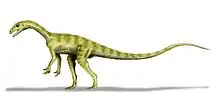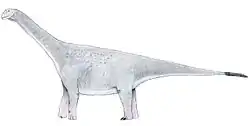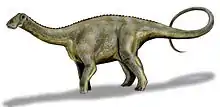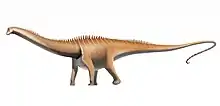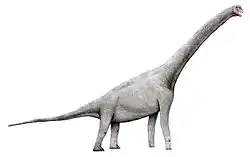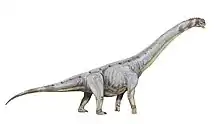Narindasaurus
Narindasaurus (meaning "lizard of Narinda Bay") is a genus of turiasaurian sauropod dinosaur from the Middle Jurassic Isalo III Formation of Madagascar.[1][2] The type species, N. thevenini was formally described by Royo-Torres et al. in 2020.[3] The holotype, which consists of one specimen, is currently stored at the Muséum national d’Histoire naturelle and has been since 1906 or 1907.[2]
| Narindasaurus | |
|---|---|
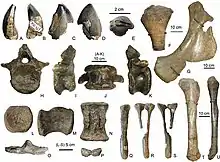 | |
| Holotype | |
| Scientific classification | |
| Kingdom: | Animalia |
| Phylum: | Chordata |
| Clade: | Dinosauria |
| Clade: | Saurischia |
| Suborder: | †Sauropodomorpha |
| Clade: | †Sauropoda |
| Clade: | †Eusauropoda |
| Clade: | †Turiasauria |
| Genus: | †Narindasaurus Royo-Torres et al., 2020 |
| Species: | †N. thevenini |
| Binomial name | |
| †Narindasaurus thevenini Royo-Torres et al., 2020 | |
Age determination studies performed using growth ring counts suggest that this sauropod took 31–45 years to reach sexual maturity[4][5] and was relatively fast-growing given the presence of a large amount of fibrolamellar bone.[6]
Discovery and naming
The holotype was discovered in the Isalo III Formation around 1906 and was briefly noted by Paul Lemoine in 1906.[1] Armand Thevenin (1861-1942) was the first to diagnose Narindasaurus. In 1907, he placed it within the now obsolete species "Bothriospondylus madagascariensis".[2] It was briefly mentioned in 1972[7] and it was reevaluated in 2008 and 2010 as both a distinct taxon and a non-neosauropod eusauropod.[8][9] It was classified as a turiasaur in 2016.[10] The species Narindasaurus thevenini was formally named in 2020.[3]
The holotype consists of a partial skeleton composed by a right maxillary or premaxillary tooth (MNHN MAJ 423), an anterior caudal vertebra (MNHN MAJ 424), a posterior caudal vertebra (MNHN MAJ 426), a middle-anterior chevron (MNHN MAJ 425), a right ulna (MNHN MAJ 427), a right tibia (MNHN MAJ 428), a right fibula with a distal chevron attached (MNHN MAJ 429) and a left pubis (MNHN MAJ 430).[2][3]
Gallery
 Left pubis (MNHN MAJ 430)
Left pubis (MNHN MAJ 430) Humerus
Humerus
References
- Lemoine P. 1906. Études géologiques dans le nord de Madagascar. In: Herman A, ed. Contributions à l’histoire géologique de l’Océan Indien. Paris: Librairie Scientifique, 1–520.
- Thevenin A. 1907. Paléontologie de Madagascar. IV Dinosauriens. Annales de Paléontologie 2: 121–136.
- Rafael Royo-Torres; Alberto Cobos; Pedro Mocho; Luis Alcalá (2020). "Origin and evolution of turiasaur dinosaurs set by means of a new 'rosetta' specimen from Spain". Zoological Journal of the Linnean Society. Online edition. doi:10.1093/zoolinnean/zlaa091.
- de, Ricqlès (1983). "Cyclical growth in the long bones of a sauropod dinosaur". Acta Palaeontologica Polonica. 28: 225–232.
- de Ricqles et al., (1983)In Skeletal Biomineralization: Patterns, Processes, and Evolutionary Trends (J. G. Carter, Ed.). Vol. 1, pp. 471-530. Van Nostrand-Reinhold, New York.
- Rimblot-Baly, F.; de Ricqlès, A.; Zylberberg, L. (1995). "Analyse paléohistologique d'une série de croissance partielle chez Lapparentosaurus madagascariensis (Jurassique Moyen): essai sur la dynamique de croissance d'un dinosaure sauropode". Annales de Paléontologie. 81: 49–86.
- Besairie H, Collignon M. 1972. Géologie de Madagascar, 1. Les terrains sédimentaires. Annales Géologiques de Madagascar 35: 1–463.
- Läng E. 2008. Les cétiosaures (Dinosauria, Sauropoda) et les sauropodes du Jurassique moyen: révision systématique, nouvelles découvertes et implications phylogénetiques. Unpublished Ph.D Thesis, Muséum national d’Histoire naturelle, Paris.
- Mannion PD. 2010. A revision of the sauropod dinosaur genus ‘Bothriospondylus’ with a redescription of the type material of the Middle Jurassic form ‘B. madagascariensis’. Palaeontology 53: 277–296.
- Mocho, Pedro; Royo-Torres, Rafael; Malafaia, Elisabete; Escaso, Fernando; Silva, Bruno; Ortega, Francisco (2015-06-19). "Turiasauria-like teeth from the Upper Jurassic of the Lusitanian Basin, Portugal". Historical Biology. 28 (7): 861–880. doi:10.1080/08912963.2015.1049948. ISSN 0891-2963. S2CID 129076933.
